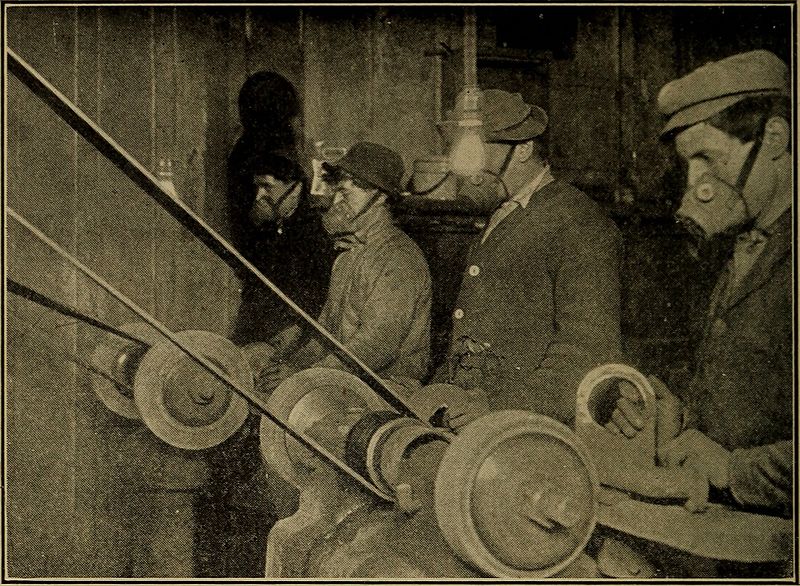For the average American, having a job is an essential aspect of life; without a stable source of income, it is nearly impossible to survive in today’s world. Working during the 1900’s was not as easy it may seem at first look. Although it is true that there were many new jobs available in factories, working in them posed many significant consequences for the employees. Working was more difficult than expected, Americans suffered from working extreme hours around heavy machinery, which made fatalities skyrocket. The government did eventually pass labor laws, but it could not undo the difficulties people had faced.
These laws were meant to maintain the health of workers while providing them safety and compensation for work-related injuries.1 The working conditions of factories produced many hardships for Americans. The pay was barely enough to feed one mouth, so it was rather impossible to feed a whole family. In today’s society, minimum wage employees complain about getting paid $7.25 per hour, but there was no minimum wage in 1900. The average person today works 40 hours per week, which is $290 per week at minimum wages. Most paychecks are handed out every two weeks; therefore, most Americans can make up to $580 in one paycheck. In 1900, the average American worker was paid a measly $400-$500 over the span of a year; this is less than the typical American makes in one paycheck today. Even adjusted for inflation, a higher percentage of Americans lived in poverty then than they do today.2
Although some people believed that only males should hold jobs, there was actually an increasing number of females and children being employed in the workplace. However, the women and children being hired were typically not prepared for career choice jobs, forcing them to work in factories. Factories took advantage of individuals that would work for lower wages without outcry; more often than not, these individuals were comprised of women and children that were desperate for the opportunity to bring any form of income into the household, not realizing that their lower pay may decrease the pay that the father of the house received.3
By 1900, almost 17 percent of females comprised the industrial workforce, most of whom were single and trying to support themselves, their children, or their siblings.4 The women who typically worked were usually white and tended to be under the age of twenty-five; however, a vast majority of workers were the daughters of immigrants or were immigrants themselves.5
The main workplace for women was in the textile industry; this was because most women could not handle the heavy manual labor like men could. In these factories, women typically were paid wages of $6-$8 per week, causing their average income to fall well below the average wages for men. With such a low paycheck, most women found themselves in poverty, and some were forced with no other option besides prostitution.6. Another issue with women working is that society believed that it was wrong for women to be in the workplace and out of the household; so the women who had to take up a job were scrutinized. This view on women working did change over time, with the majority of communities seeing married, employed women as a strong figure, opposed to being the quiet, nurturing, and delicate character that was expected of them.
Due to such low income, most family members were forced to get jobs. This meant that when the man could not solely support the family, women had to step up. When even this did not produce the amount of money needed to sustain the family, children were next in line to find a job. Children that tended to work were often from families whose husbands denied the right for their wives to work; so they helped provide for the family so their mother did not have to work. At least 1.7 million children under the age of sixteen were employed in factories or fields by 1900. About 10% of girls were the age of 10-16 and boys made up 20% of all ages of employed workers.7 Unlike the wives in the textile industry, most children found themselves working in agriculture for an average of twelve hours a day, performing arduous tasks such as picking and hoeing the fields.8 Children in the South usually worked at night, with employers keeping them awake by throwing cold water in their faces. The majority of female children had to cut fruits and vegetables for sixteen hours a day. Even though laws were passed to protect children, they were still vulnerable to getting severely hurt while working; some of these injuries turned fatal quickly.9

Other hardships Americans faced was the amount of hours that made up a typical working day. Most Americans had to work 10-12 hours, six days a week. If they worked in the steel industry, the typical working day consisted of 12 hours.10 The hours may not have seemed so bad, and many of us may have already worked that long for a shift, but the working conditions they were subjected to at the time made it much more difficult. The conditions were labeled as unfit and unhealthy for humans and working for long, exhausting hours did not help reduce the number of injuries. There were several accidents that ended in tragedy, labeling factories as unsafe for working. Although injuries were common, it was very rare for a victim of these on-the-job injuries to receive any type of compensation from their employers or the government. Eventually, workers lost control of the conditions for their labor. With this loss of control, more problems appeared, including already low wages being lowered further and long hours turning longer.
Having a job was never an easy task to maintain in the past. Through the difficult times, Americans did not give up; they fought through the struggles to create a successful life. In the end, one can say the labor challenges were worth the struggle because over time, the United States has significantly improved the laws that we see enacted today that are used to protect all individuals working, as well as protecting children from being subjected to work at young ages.
- “Labor Laws and Regulations,” Monthly Labor Review 7, no. 4 (1918): 240. ↵
- Alan Brinkley. American History: Connecting with the Past Volume 2, 15 edition (New York, NY: McGraw-Hill Education, 2014), 477. ↵
- Alan Brinkley. American History: Connecting with the Past Volume 2, 15 edition (New York, NY: McGraw-Hill Education, 2014), 477. ↵
- Alan Brinkley. American History: Connecting with the Past Volume 2, 15 edition (New York, NY: McGraw-Hill Education, 2014), 477. ↵
- Alan Brinkley, American History: Connecting with the Past Volume 2, 15 edition (New York, NY: McGraw-Hill Education, 2014), 477. ↵
- Alan Brinkley, American History: Connecting with the Past Volume 2, 15 edition (New York, NY: McGraw-Hill Education, 2014), 478 ↵
- Alan Brinkley, American History: Connecting with the Past Volume 2, 15 edition (New York, NY: McGraw-Hill Education, 2014), 478. ↵
- Edward N. Clopper, “The Federal Child Labor Law,” The Elementary School Journal 17, no. 5 (1917): 327. ↵
- Albert J. Beverage, “Child Labor Laws,” The Journal of Education 68, no. 12 (1908): 330. ↵
- Alan Brinkley, American History: Connecting with the Past Volume 2, 15 edition (New York, NY: McGraw-Hill Education, 2014), 477. ↵



46 comments
Cesar Zavala
It’s hard to believe that not that long ago, working conditions were this awful and crude. The statistics and percentages presented in this article sure helped paint a better picture for me and all other readers of how bad conditions were during this time in which the U.S was growing. If it weren’t for these people’s hardships and their cry for help and reform, people today might still be working in horrible conditions such as this.
Lianna Ybarra
In my opinion, I think that it is good that women work to either help support their families or themselves. It not only teaches different skills, but helps you grow as a person. As a working person, I know that sometimes the pay always isn’t enough to cover expenses but at the same time, we can’t be complaining because of how low their pay was back then. I’m glad though that the government capped the hours of work and has different labor laws for workers, especially those who work in factories because it can be a risk factor.
Sam Vandenbrink
Great, very informative article! Although I do not believe in all the things stated in the article, when there is work involved allot of the time there is a paycheck involved as well. But wages increase and decrease with the economy. Allot of pay is controlled by time as well, as years keep going on minimum wage is going to keep increasing. But one can’t compare pay from 1900 to the present because of everything has become more expensive, and living life isn’t quite as simple anymore.
Priscilla Reyes
Many of the jobs at the time were easier for men to obtain and this made it hard for a family to thrive economically. However, jobs that women were allowed to do were of cheap pay and could lead them to drastic measures. It’s crazy to think how today, women are still being paid less than men! Another striking thing mentioned was the fact that even though families were struggling, some men choose to not let their wives or mothers work.
Very interesting article!
Nicolas McKay
The Gilded Age was no doubt a very difficult period in American History. The Jungle by Upton Sinclair is a great portrayal of the time mentioned in this article. I cannot even imagine working under the conditions that they were forced to endure, and the fact that they were able to is in my eyes nothing short of a miracle. I’m sure they would be glad to see the new regulations put into place since then.
Aaron Jaramillo
Great interesting article. Working people today need to read your article, it will make them appreciate their jobs today. How sad it was that the working women and children, thinking they were helping out their families really hurt them by working lowing the main breadwinners overall pay. This article was quite eye opening to see what hardships and struggles early Americans went through to put food on their table. Great work.
Jacob Hall
I always knew that back then people complained about a woman getting a job. However I did not know that in many cases it was necessary for them to have one. i always thought that the whole mentality of the man must support the family was made because of the fact the, well they could. It was actually the other way around though, which is something I did not know. The man could not support the family so the wife had to work too, and if not her the children. I like how this article does a great job of enlightening our views of working life in the 1900’s, or at least it did for me. I also really like how you made comparisons between today’s world, and the world of 1900, it really helps to convey your point.
George Manzanares
Interesting article! The Industrial Revolution did bring about a pathway for America to rise as a global power. However, the cost had its fair share of adversity. Many of the working folk suffered heavily within the factories. Good job on showing how horrible the working conditions were not only for men but also women and children. It is due to that horrific period that we have laws in plays today to prevent such exploitation. Good job!
Maalik Stansbury
This is an interesting how employees were actually treated back in the day. I didn’t know there were a form of mistreatment produced within the workplace. I glad the laws and regulations have changed. Thanks for the cool article and great presentation of it.
Mariana Sandoval
It’s a good thing that the US enforced laws to better protect workers because working for long hours in unsafe conditions for little pay is no fun and is honestly unethical. It’s really sad that women were scrutinized for working when that was their only choice. If their husbands weren’t being paid enough, what else were they going to do?